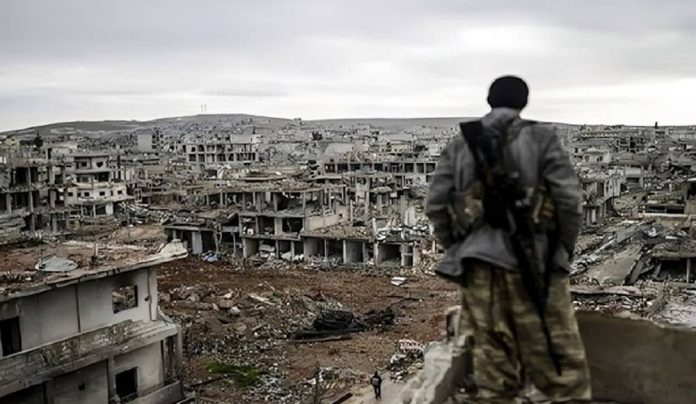Lessons from History: Halting the Iranian Regime’s War Machine

Written by
Shahriar Kia
gaza destruction soldier staring
Three-minute read
Understanding the Iranian regime’s policies and tactics, known for its deception and duplicity, requires examining the statements of its officials through the lens of historical context and past actions.
In his Nowruz message on March 20, Ali Khamenei, the regime’s Supreme Leader, emphasized the importance of the “Palestine and Gaza issue,” declaring, “Today, the top priority is the issue of Palestine and Gaza. Resistance in West Asia is now a fundamental issue.”
For conventional politics, it might appear difficult how an issue seemingly confined to the Arab world could take precedence for Iran, a nation grappling with profound economic, social, and political challenges of its own. This is especially notable for a regime experiencing diminishing stability over the last seven years due to successive uprisings and the relentless efforts of an organized resistance movement, operating tirelessly both within the country and beyond its borders, aimed at toppling the regime.
To interpret Khamenei’s remarks, one must evaluate them in the context of Iran’s recent history and its regime’s performance. Khamenei, in dealing with the explosive conditions within Iran, adopted the same approach that his predecessor had used to instigate and engage in the devastating eight-year war with Iraq.
In the early 1980s, shortly after the Iranian people toppled the monarchy through a revolution, the former Supreme Leader Ruhollah Khomeini, instead of utilizing all resources to build the country’s institutions and fulfill his promises, began instigating Iraq and urging Iraqis to revolt against their rulers.
#Iranian Regime’s Fourfold Objectives in the #GazaCrisishttps://t.co/UXfRouGv2b
— NCRI-FAC (@iran_policy) November 9, 2023
Following the invasion of Iran by Iraq, Khomeini proclaimed war as the nation’s foremost concern and branded dissenters of his policies as foreign mercenaries. He termed this conflict a “divine blessing,” stating, “Every day, we are bestowed with a war that yields benefits across all domains. We expand our revolution globally through war. Our struggle represents a perpetual battle between right and wrong.”
Thirty-six years after the war with Iraq, the remarks of the regime’s officials concerning the Gaza crisis suggest that their engagement in warmongering aligns with the regime’s policy of self-preservation. On March 22, Ahmad Alamolhoda, the Supreme Leader’s representative in Mashhad, said, “Gaza has sparked a transformative shift, altering the course of history and undermining the dignity of America and the Global Arrogance before all nations, including those who once relied on them and held hope.”
Events clearly showed that Khomeini had no intention of ending the war with Iraq. Despite the withdrawal of Iraqi forces from Iranian territory in 1982, he consistently rejected Baghdad’s ceasefire requests and disregarded all international mediation efforts. Embracing the slogan “Liberating Quds through Karbala,” Khomeini staunchly declared his commitment to continue the war “until the last brick of Tehran’s houses still stand.”
However, when the National Liberation Army of Iran (NLA) liberated the border town of Mehran in June 1988 and Iranian freedom fighters rallied with the chant “Today Mehran, tomorrow Tehran” atop their tanks, Khomeini was compelled to reassess his stance.
Watch and judge how "regime change" has evolved into the primary concern for #Iran's state officials pic.twitter.com/bGybzQ5oZO
— NCRI-FAC (@iran_policy) September 16, 2023
On July 18, 1988, the Iranian regime declared its readiness to accept Resolution 598 to the United Nations Secretary-General. In a message to his followers, Khomeini compared the ceasefire to a “chalice of poison,” pledging to explain the reasons behind this consequential decision later. Nevertheless, he never wavered and refrained from openly acknowledging his abrupt change of heart.
However, it is evident that he was forced to retreat from his war strategy to safeguard his own rule against a well-organized and armed Iranian force.
In June 2008, Mohammad Esmail Kowsari, a commander of the Islamic Revolutionary Guard Corps (IRGC), explained, “The enemies had orchestrated truly extensive conspiracies, as the hypocrites had done before the Eternal Light Operation. They claimed to have carried out a successful operation in Mehran and had raised the slogan ‘Today Mehran, tomorrow Tehran’ one or two months prior. Consequently, by acquiring various heavy and semi-heavy weapons such as artillery, they had organized themselves. The acceptance of the [598] resolution by His Eminence the Imam neutralized all of these conspiracies!”
Today, Khamenei’s attempts to capitalize on the Gaza crisis and achieve rapid victories akin to those in the 33-day and 22-day wars have failed. The current crisis in the Middle East developments have raised global awareness about the threats posed by Tehran. Moreover, Khamenei’s ambitions to showcase strength in the March 1st elections have been thwarted, with significant potential domestic repercussions.
The question of why Khamenei, amidst ongoing domestic crises, prioritizes the Palestinian issue in his key speeches, has become a familiar tactic of Tehran. While the world acknowledges this playbook, finding a solution remains elusive. Indeed, drawing from history, the only force capable of effectively pushing back against the regime’s war agenda is the very entity that the regime works tirelessly to suppress and evade.

